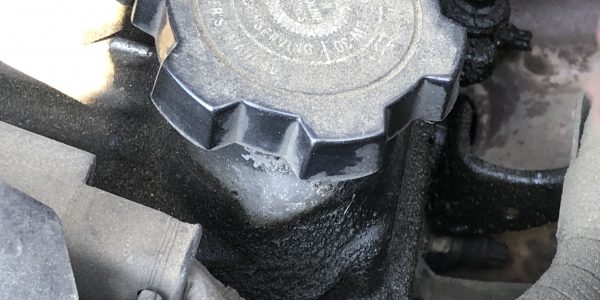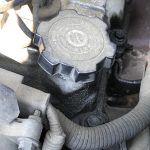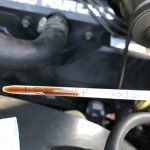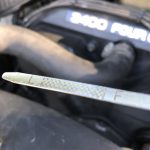The 7 engine issues to avoid in a used car will give you the knowledge you need to reduce the chances of purchasing a used vehicle with a bad engine. When you’re looking for a good used car the one thing that matters the most is the color, ok, so to some of you that might be your number one concern. I would argue that when you are looking at a used car the most important part and most expensive to fix is the engine. I was asked the other day if there is any way to know that you have an engine that is good when buying a used vehicle.
When I was working as a technician I performed many ‘checkouts for purchase’. This is when a prospective buyer would bring in a vehicle to see if there were any major issues with the vehicle. I also made a list of possible repairs that might need to be done. In this article I’ll be going over just one aspect of what I did during a ‘checkout for purchase’.
When dealing with a used vehicle that you don’t have history on there is really no way to be 100% sure how long the engine will last. There are many ways that I have learned over the last 30 years on how to rule out big and expensive issues with used car engines.
Won’t start
I frequently see vehicles for sale that state that they won’t start. Something like … “Runs great, needs battery” or “Just needs fuel pump and it will run great” or “Needs a $30 relay” or “Starter is bad, but runs great.” I recommend that you stay away from these vehicles. If you can’t start it there are a myriad of things that could be wrong with it that you won’t know until you get it to start.
Will
…it start when I replace that one part?
…there be an engine noise?
…the brakes, power steering, air conditioning, and alternator work?
…the transmission shift or shudder or slip or ???
…it overheat on a short test drive?
The list goes on. I would suggest that you pay scrap price for a vehicle in this condition. If you purchase it, make the assumption that you will have to replace the engine, transmission and possibly other large or expensive parts. This should minimize the risk of losing a great amount of money on the deal. Yes, it could be that a $300 part would fix it, or it could be that it takes $3,000 or $30,000 to fix all the issues it has.
Now you know how to deal with a vehicle that won’t start. If it does start, here are several things that you need to check for to increase the probability that you’re getting a good engine. These are the rest of the engine issues to avoid in a used car.
Leaks
Engine oil leaks can cause an engine to run low on oil if they aren’t monitored. Oil leaks can get expensive to repair depending on where they are loacated.
Engine leaks will look like oily or greasy stains on the outside of the engine. If they have been there for a while they may have dirt in them which makes for a black goo that coats part of the engine.
Engine coolant leaks can cause an engine to run hot if not monitored. Coolant leaks can range from inexpensive to moderatly expensive to repair but left unchecked can ruin an engine.
Engine leaks will be where there are seams in the casting or between parts. Usually the seal between two parts has failed and now is leaking engine oil or coolant out of the engine.
Where are you going to look? Check these things under the hood and under the vehicle.
- Rubber gaskets (under the hood look for greasy stains and dirt caked on by oil)
- Seals (again under the hood and also under the vehicle look for greasy stains and dirt caked on by oil)
- Casting seams (same as seals)
- Front main (near the front bottom of the engine behind where the drive belts are)
- Rear main (near the rear bottom of the engine in the seam between the engine and transmission)
- Oil pump (usually this is around the same area that the front main would leak)
- Valve cover gaskets (top of the engine around the seam between the valve cover and the block)
- Hoses (coolant hose at the top of the radiator and also at the bottom of the radiator)
- Radiator (look for leaks around the radiator seams)
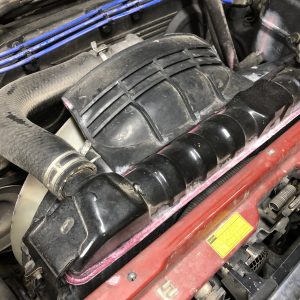
The top tank on this radiator is leaking. It shows up as pink around the tank since the coolant is red.
 WARNING: The owner could have detailed the engine bay and cleaned up any signs of oil or coolant leaks. If the engine is super clean it will be difficult to tell if there are any leaks.
WARNING: The owner could have detailed the engine bay and cleaned up any signs of oil or coolant leaks. If the engine is super clean it will be difficult to tell if there are any leaks.
Oil Issues
While under the hood and before starting the engine, pull the oil dipstick and check the condition and level of the engine oil. Read my Preventative Engine Maintenance 101 for an in-depth explanation on how to check your engine oil.
Check the level to make sure that it is near the full level.
 WARNING: If the oil is spot on the owner could have just changed the oil or topped it off.
WARNING: If the oil is spot on the owner could have just changed the oil or topped it off.
Check the condition of the oil. New engine oil is a golden brown like honey, sometimes so light that it’s almost clear. Darker colors indicate that the oil is dirty, old, or possibly burnt.
 WARNING: If the oil is super clean it quite possibly could mean that the owner had just changed the engine oil.
WARNING: If the oil is super clean it quite possibly could mean that the owner had just changed the engine oil.
Smell the engine oil. If the engine oil smells like gas you could have excessive wear in the engine. This causes the fuel to get out of the combustion chamber and into the oil.
WARNING: Fuel will break down oil after a while.
While you are under the hood and before you start the vehicle you should also check a couple other places. Remove the oil filler cap and check the inside of the cap.
You’ll want to look for a couple of things. One would be to check to see if there is moisture on the inside of the cap. Tilt the cap back and forth to see if the moisture has a green tint to it. This could indicate a slight coolant leak that is letting coolant into the oil chamber.
Another thing to look for is a gooey substance under the oil cap. Sometimes there is a thick substance under the cap with the consistency of a gel. This could indicate a lack of maintenance for an engine and is expensive to fix.
While you have the oil filler cap off you should try to look into the valve train. You may be able to see indications of good or bad maintenance. If you see metallic pieces that are shiny or have a tan or brown look to them the engine is probably been taken care of. If you see black chunks of the oil gel we looked for under the oil cap it’s probably time to look for something else.
Engine oil is the lifeblood of your engine. This can be one of the most detrimental engine issues to avoid in a used car.
Hard starting
Once you have looked over the vehicle and engine for leaks and the seller states that the engine will start you will want to verify that it will start. If the vehicle doesn’t start on the first attempt it may be suspect. Make another attempt or two. A hard starting vehicle could have issues with fuel pump, fuel pressure, ignition or compression issues. Remember you need air, fuel, and spark to get it running. Any one of those that are out of spec can cause a hard start condition.
Most fuel injected vehicles should start and idle on their own without any outside inputs except for the turning of the key. The vehicle should start and idle smoothly around 1200 RPM if the engine is cold. If the engine is warm or hot the idle will probably be around 750-850RPM.
Obviously you’re not here to help fix or diagnose this vehicle for the owner, you just need to know if the vehicle, the engine specifically will be reliable. As your skill level and confidence in diagnosing starting issues increases you will be more comfortable knowing what to accept as your risk. If you question the starting capability move on to the next possibility.
Smoke
Smoke can mean a couple of things depending on where it is showing up, the color it is and when it occurs.
- buy Lyrica usa Dark smoke (black or blue) on startup
- If the smoke goes away after a few minutes of running it usually means that there is oil seeping through the valve stem seals when the vehicle sits. It runs into the combustion chamber and burns off shortly after startup.
- Marsabit Dark smoke (black or blue) on startup that continues throughout the test drive.
- Usually means that the engine oil is getting past the piston rings and burning in the cylinder
- Light smoke (white or gray) on startup
- This usually means that the engine is burning coolant. Coolant doesn’t burn real well, so the engine may run rough while it is burning off this coolant. If the engine is burning coolant the best case scenario is that the head gasket is compromised, worst case would be that the engine block is cracked.
- Smoke or burning smell coming from under the hood during test drive.
- This usually means that there is an oil leak under the hood that is dripping onto the exhaust. May not be a fire hazard, but it could mean that there is an active oil leak. Oil leaks can get expensive to fix. Might be best to move on to another prospect.
Smoke is one of the engine issues to avoid in a used car. I recommend finding something that doesn’t smoke.
Engine noises
A basic rule of thumb is that the lower and louder the noise or sound is, the more expensive it is to fix. Higher pitched noises are usually less expensive. This isn’t a hard and fast rule, but something to consider when listening for engine noises.
- Rod Knock
- You’ll hear this if you rev the engine and then let off the gas. It will be a low pitched knocking or rattling sound.
- Timing Chain Noise
- Best way to find this engine noise is to start it when it’s cold. Usually if the timing chain is loose, the guides are shot or the chain tensioner is going out you will hear a rattling sound right after start up until the oil pressure builds up. This is usually the chain slapping up against the guides
- Sticking Lifter
- Best way to find this engine noise is to start it when it’s cold since as it warms up the lifter may loosen up. If it’s sticking some of the time you’ll hear a light tapping sound coming from the top of the engine.
- Piston Slap
- Some engines have some piston slap which sounds like a light rod knock. With any of these noises I would recommend to skip it and look for something else.
 WARNING: Engine noises are one of the most expensive engine issues to avoid in a used car.
WARNING: Engine noises are one of the most expensive engine issues to avoid in a used car.
Rough running (idle or accelerating)
Once you start the vehicle it should idle smoothly. A rough idle can indicate anything from an easy vacuum leak or bad spark plugs. Some of the worst case scenarios could be a blown head gasket or overly worn rings. These last two would require a rebuild or a new engine. Probably not a headache you want to have if you’re looking for reliable transportation.
BONUS: Service history
This isn’t an issue with the engine, but it could clinch the deal. If the seller has documentation of regular oil changes, maintenance items (timing belt, water pump, hoses, etc.) and major services that you can view it might be a great confidence booster that this vehicle has been well taken care of. If the vehicle condition is questionable and there is no service history you may want to keep looking.
At a minimum you want to know if the timing belt was changed on time and when it was last done. This can be one of the most expensive maintenance items on a vehicle. If the engine is an interference engine, where the pistons and valves will collide. A broken broken timing belt on an interference engine can result in having to replace the whole engine. There are websites that you can put the vehicle information in to find out whether the engine is an interference design or not.
Conclusion:
Knowing the 7 engine issues to avoid in a used car won’t always guarantee that the engine, or vehicle for that matter, will last a long time. If you avoid these engine issues you will rule out big and expensive issues with a used car engine. This will raise the odds that your vehicle will be reliable, last longer and get you where you need to go. It will also save you from having to dump a bunch of money in a ‘new to you’ car. That’s what you need in a vehicle.
One of the best pieces of advice I would give you is to shop around. If you find a vehicle model that you like, try to test drive 3 or 4 of them at minimum, mostly if you haven’t driven that particular year/model before. Once you drive a few you will start to get a feel for sounds, acceleration, shifting, comfort, features and a lot more that only experience will provide.
